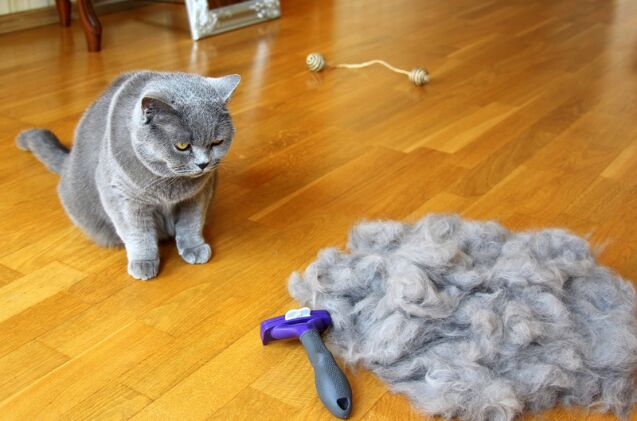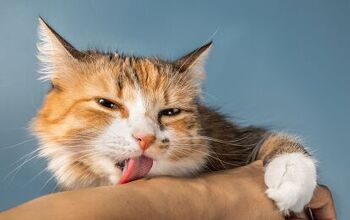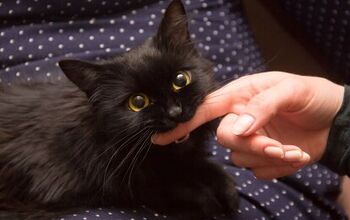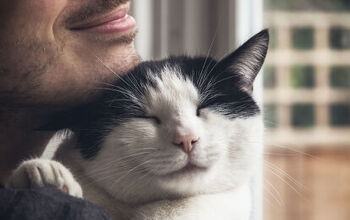Why is My Cat Shedding in October?

The fall colours are out on full display, and temperatures are starting to dip, but for many cat parents, this time of year introduces another interesting change – their cats are starting to shed much more than usual. But if you’re suddenly noticing a trail of fur around your house, you have a few questions, including:
- Why is my cat shedding in October?
- Is it normal for a cat to shed more during the fall season?
- When should I be worried about my cat’s shedding?
Don’t worry. We have you covered! This blog post will discuss seasonal shedding and how it may affect your cat. Plus, we have assembled a list of tips and tricks to help you deal with the increased shedding during fall, ranging from how to help your cat stay comfortable to keeping your house clean (or as clean as can be expected).
Let’s dive in…
Why Do Cats Shed?
Whether you are a first-time cat owner experiencing shedding for the first time or a lifelong cat lover who simply hasn’t explored the reason why our cats shed – let’s talk about why this occurs. After all, isn’t losing hair a sign of illness or disease in humans?
Shedding is a natural process in animals like cats where dead or damaged hair falls loose. This is essential for your cat’s skin and coat health. The amount of hair your cat sheds will depend on several factors, including the breed, age, overall health, and the time of year. That’s right, the time of year does have an impact on the shedding cycle…
Is it Normal for Cats to Shed in the Fall?
There are two times each year when you may notice an increase in hair collecting around your house. Commonly referred to as “shedding season,” this heavy shedding activity falls in the spring and the fall as your cat’s coat adapts to the change in temperature. The heavy winter coat is shed in the spring to make way for a lighter summer coat.
Then, the reverse happens in the fall as they set themselves up for the best chance of survival during the cold of winter. Check the temperature – if it’s starting to drop and there are colder days ahead, you can expect to see the shedding activity pick up in the coming days.
How Long Does Seasonal Cat Shedding Last?
Unfortunately, there is no single answer to this question – instead, the length of time your cat will shed each “shedding season” will vary. Cats that shed a lot, like the Siberian, tend to have a much longer shedding season, with a lot more hair being released. In this case, it could take a couple of months before things return to normal. But remember, they will continue to shed at a lower rate throughout the year.
On the other end of the spectrum are low-shedding cats like the Russian Blue and hairless cats, also referred to as hypoallergenic cats, like the Sphynx. Low-shedding cats will still see an increase in shedding with seasonal shedding patterns, but it will still be minimal compared to many other cat breeds. While hairless cats don’t shed (as they only have minimal fuzz and no significant fur growth), they have surprisingly high grooming needs to keep them looking their best.
How Do I Know if My Cat is Shedding Too Much?
While shedding is a natural and healthy process for your cat, there is also a chance that they may experience it more than usual when dealing with some health problems or illnesses. As cat parents, there are other signs of trouble that we should be watching out for, including:
- Excessive biting, licking, or scratching
- Bald spots
- Sores or wounds from scratching/biting
- Red, irritated skin
- More hairballs than usual
- Dry, lifeless fur
Excessive shedding isn’t necessarily major or life-threatening, but it could be a sign of trouble. Shedding more than usual could result from a hormonal imbalance, allergy, poor nutrition, hyperthyroidism, parasites, or a skin infection. It can also occur when a cat is unable to keep up with their grooming needs due to an injury or arthritis. For some cats, excessive grooming leading to increased shedding could be a response to stress and anxiety. If you notice any of these signs, you should contact your veterinarian.
Tips for Dealing with Seasonal Cat Shedding
Start by Ruling Out a Medical Condition
As we just mentioned, excessive shedding may be a red flag that something is wrong. If you notice any other symptoms listed above or anything that seems “off,” it’s better to be safe than sorry. Make an appointment with your veterinarian for a checkup and any necessary testing to ensure that there is no underlying problem.
Groom Your Cat Regularly
Of course, for optimal skin and coat health, you must prioritize your cat’s grooming needs. Choose the best brush for your cat’s fur type. For medium or long-haired cats, you should take time to brush your cat daily with a wide-tooth comb or de-matting comb. Short-haired cats don’t need to be brushed as often, but they still should be groomed at least once a week with a soft bristle brush or fine-tooth comb.
Cats are generally good about staying on top of their grooming, but there are situations where a cat may struggle to keep up with their needs. If your cat has recently had surgery or suffered an injury that prevents them from being able to reach all areas of their body, or if they are a senior with arthritis impacting their flexibility and mobility, you may need to help more.
Bathing your cat can also help to reduce shedding by removing dirt, debris, and dead skin cells that could otherwise cause skin irritation. How often to bathe your cat will largely depend on their lifestyle. While some cats need to be washed regularly (like our girl Pippen, who loves to roll in the mud on hikes), others can spend a long time staying on top of their bathing needs.
Do Regular Body Checks
One way to stay on top of your cat’s health and catch any red flags quickly is to do regular body checks or scans. This means taking time to part your cat’s fur and examine the skin for signs of inflammation, redness, sores, or other indicators of irritation.
If your cat is used to and comfortable being handled, this process may be easy. However, if your cat dislikes being held, they may fight back. With our cats, we usually wait until they curl up in our lap for a nap and carefully check their body over as we are petting them. It makes the process easier and more comfortable for them as we keep them calm and relaxed throughout the time it takes us to look. And, of course, always follow up with a treat for a job well done!
Reduce Stress When Possible
As we previously mentioned, shedding can be made worse when cats feel high stress and anxiety levels. Therefore, one way to keep shedding under control (as much as possible) is to create a calm and relaxing environment for your cat.
Ensure your cat has a “safe space” they can retreat to whenever they feel uncomfortable. This is especially important if you have young children or other pets. You can do this by offering a tall scratching post or cat shelves to climb onto or blocking off an area of the home with a small cat door to allow only your cat access. In an ideal cat environment, they will have the option of a high perch or a hiding space to choose from, depending on their mood and personal preferences.
If there is something noticeable causing stress for your cat, address it directly.
Some examples of stress triggers include a move, an extensive renovation or change in the home, someone leaving/joining the household, and being bullied by another household cat. Not all these situations can be avoided, but you can take steps to help your cat relax as they adjust to their new “normal,” such as calming treats and pheromone diffusers.
Make Changes to Your Cat’s Diet
Your cat's diet directly impacts the health of every system in their body, including their skin and coat health. Take a moment to reassess what you are feeding, including both food and treats. You want to ensure that you provide a complete and balanced food and not fill your cat’s stomach with too many unhealthy treats. For cats that may struggle with their skin and coat health, there are specialty foods available that are formulated to target the problem. On the other hand, if your cat’s shedding is escalating due to allergy issues, you may want to switch to a hypoallergenic diet.
Selecting the best cat food can be a struggle for most cat parents. There is a lot of information out there regarding what to watch for and what to avoid, much of it conflicting. We recommend starting with a call to your veterinarian or a certified pet nutritionist for professional assistance in planning the best diet for your feline friend.
Consider Introducing Supplements
You may have been told before that offering your cat a multivitamin can help ensure that you meet their nutritional needs, even if their food may be missing something. But the pet supplement industry has far exceeded that. Many great products are available that leverage the health benefits of natural ingredients to support and improve their health, including skin and coat health products.
In our house, all three dogs and two cats receive Pure Wild Alaskan Salmon Oil from Zesty Paws on top of their meals. Using fish oil, like salmon oil, is a great way to give your cat some Omega-3 fatty acids. Plus, it’s delicious (or so they seem to believe based on how quickly they dig in). This will help maintain the optimal moisture level in their skin, promote a shiny, healthy coat, reduce shedding, support better wound healing (if your cat has wounds from scratching), and more.
Encourage Proper Hydration
While most people associate a cat’s coat and skin health solely with their food, water also plays an essential part. The healthier your cat is, the less likely they will experience excessive shedding. But cats are notorious for not drinking enough water. Pay attention to how much water your cat is drinking throughout the day by monitoring their water dish. Experts recommend approximately half a cup of water daily for every 5 pounds of body weight.
If you are concerned that your cat’s hydration levels are too low, there are steps you can take to help encourage them to consume more water. First, consider feeding canned food or rehydrating their kibble by adding a little water before feeding. Most cats will lap up this “gravy” without a second thought, even if they turn their nose to regular water.
Some cats are particular about the finer details in their lives, including the type of bowl that they are drinking out of. Try switching to a different material (plastic, ceramic, stainless steel), a different height, or a different location for their water bowl. There are also water fountains that encourage cats to drink more with fresh, moving water.
Contain the Mess
Regardless of the effort you put into minimizing your cat’s shedding, it will still happen to some degree. Try creating a cozy area for your cat to hang out and nap by moving a scratch post or cat bed to their favorite area of the home. If they spend most of the day sleeping in that location, it will also be the spot where you find most of the shed fur. You can also add a blanket for easier cleaning.
Final thoughts: Seasonal Shedding in Cats
Shedding is normal, but it can get much heavier during the spring and fall months. While there is no solution to eliminate shedding completely, you can help manage and control your cat’s shedding to some degree by improving their diet, offering supplements with Omega-3 fatty acids, and maintaining a regular grooming schedule. If you notice any signs that your cat may be experiencing skin irritation or excessive itchiness during shedding season, contact your veterinarian to determine if there is a medical explanation.

Britt Kascjak is a proud pet mom, sharing her heart (and her home) with her “pack” which includes her husband John, their 2 dogs – Indiana and Lucifer – and their 2 cats – Pippen and Jinx. She has been active in the animal rescue community for over 15 years, volunteering, fostering and advocating for organizations across Canada and the US. In her free time, she enjoys traveling around the country camping, hiking, and canoeing with her pets.
More by Britt
























